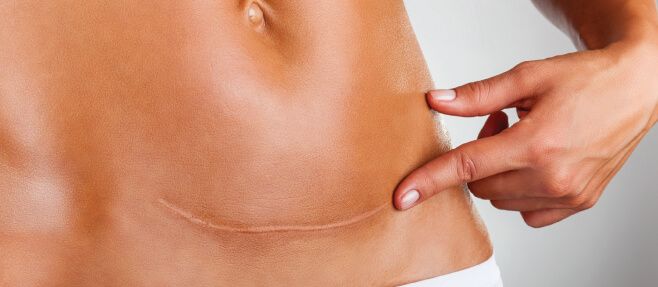How To Minimize Scarring From Plastic Surgery

Scars result from the body’s natural healing process. After injury or surgery, the body responds by producing collagen and fibrous tissue which becomes intertwined to form scar tissue.
While it is currently not possible to eliminate scars after many common plastic surgery procedures, there is a lot we can do to optimize scar appearance and scar quality.
Since it is our goal as plastic surgeons to prevent noticeable scars, surgeon factors, patient factors, and post-surgical regimen are among the most important factors we think about every time we perform surgery.
Surgery Factors
Strategic Incision Placement
A skilled plastic surgeon will strategically place incisions in areas of the body where any resulting scarring will be minimally visible.
During breast augmentation, for example, I have various incision placement options for “hiding” scars including inframammary (under fold of the breast), transaxillary (arm pit) or transumbilical (bellybutton). The same goes for tummy tuck surgery (abdominoplasty) where incisions can be made so any scarring results below a bikini bottom.
For other areas of the body there are structures called relaxed skin tension lines that guide incision placement.
Suture Choice and Surgical Technique
The surgeon’s approach to closing a surgical incision matters greatly. I like to use absorbable sutures in most of my body work. These sutures get broken down by the body over 1-2 months and there is no need for suture removal. There are times when non-absorbable sutures are preferred. For example, many surgeons will place non-absorbable sutures after eyelid surgery that need to be removed after one week. Some of the techniques I use include deep dermal interrupted sutures, running subcuticular sutures, mattress sutures, figure-of-eight sutures, and many others.
Patient Factors
Hereditary
Some of us are more likely to form favorable scars than others. Generally, the less melanin your skin contains, the better are your chances of forming good (less visible) scars.
Post-Surgery Regimen
How you care for your scars is as at least as important as the work that was done in surgery, perhaps more so. Your patience and discipline are mandatory to get optimal results.
- Wound Care Instructions: Follow all wound care instructions provided by your surgeon, which while likely include wearing dressings or bandages and ways to properly keep the wound clean.
- Compression Garments: Depending on the procedure, patients may be required to wear compression garments which help protect the wound from further trauma, minimize tension on sutures, and can help speed up overall healing.
- Sun Protection: Sun exposure can cause excess melanin production on scarring which can make them darker or discolored. Patients should avoid sun exposure and protect the area by wearing UV resistant apparel or applying sunscreen.
- Nutrition & Exercise: Eating a balanced diet, supplementing intelligently, and exercising (after being cleared by your surgeon) can assist the body in healing post-surgery.
- Stop Smoking: The chemicals found in cigarettes and vape products can negatively affect the healing process and can worsen scarring.
- Massage: The act of rubbing or massaging a scar helps make scar tissue suppler, flatter, and less firm. Make sure to discuss post-surgical massage with your surgeon
- Medical Grade Silicone: medical grade silicone products (either gels or strips) helps keep the area around the incision hydrated, positively impacting the cells responsible for the body’s scar response.
Beyond the above suggestions, we also advise patients to simply give their scar time to fade. Remember that scars take up to 18 months to fully mature scars may become thinner, smoother, and finer to a point where they become almost imperceptible
Scar Treatment Options
Despite our best efforts, it is possible for a post-surgical scar to not heal in an optimal way. Fortunately there are a number of scar treatments that can minimize the visual impact of any scar. Effective treatments include:
Steroid Injections: The injection of a corticosteroid into a scar decreases the inflammatory process within it and can positively impact the final outcome. I’ll typically perform simple treatment in the office within a few months of surgery if necessary. After injection, scar tissue may be able to be broken up with consistent massaging.
Laser Skin Resurfacing: Skin resurfacing lasers like Fraxel or ActiveFX use high energy laser light to treat scars and encourage better integration with surrounding skin.
Microneedling: Microneedling treatments can be performed to break up fibrous scar tissue. Topical treatments containing growth factors can then be applied to the scar, or injected into it.
Please reach out to us in the comments area if you have any questions!
Disclaimer: The contents of the Westlake Dermatology website, including text, graphics, and images, are for informational purposes only and are not intended to substitute for direct medical advice from your physician or other qualified professional.

Awesome post! Thank you so much for sharing such amazing content on minimizing scarring after plastic surgery. Will show our patients.
Any surgeon knows that scarring can occur from any surgical procedure. Patients can use these techniques to minimize the scar after surgery. Great tips!
One of the best ways to prevent or minimize scarring is to make sure that you take proper care of your wounds after your surgery. You will be given specific information to do this, and it is essential that you follow this carefully. Reducing your risk of infection will also reduce your risk of scarring.